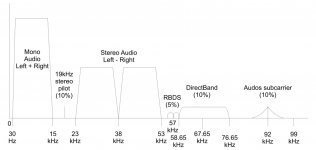I recollect there was another part, or at least that the performance had to meet the specification stipulated at type acceptance.
I know that the FM station at my school was maintained at a very high level of performance and was also the only one in the area transmitting Dolby FM (25us emphasis and Dolby B encoder). I no longer remember the numbers but they were good. IIRC it was a Harris Exciter and Harris PA. I remember it had some pretty big tubes in it. Input was around 6kW or so.
I had a tuner and tape deck that were Dolby FM compatible, and the sound quality was great, particularly since I lived near the station. (The antenna design was such that it dumped a reasonable signal level around the campus with most of the antenna radiation directed to the surrounding city and towns.)
Some local stations in the Boston area before Ubiquity HD came on line were rather proud/jealous of their signal quality - generally public radio and the one local commercial FM classical station. (The rest were all NPR affiliated stations.) The commercial pop stations were so heavily compressed they sounded like garbage. Orban was popular around here with the louder stations.
I know that the FM station at my school was maintained at a very high level of performance and was also the only one in the area transmitting Dolby FM (25us emphasis and Dolby B encoder). I no longer remember the numbers but they were good. IIRC it was a Harris Exciter and Harris PA. I remember it had some pretty big tubes in it. Input was around 6kW or so.
I had a tuner and tape deck that were Dolby FM compatible, and the sound quality was great, particularly since I lived near the station. (The antenna design was such that it dumped a reasonable signal level around the campus with most of the antenna radiation directed to the surrounding city and towns.)
Some local stations in the Boston area before Ubiquity HD came on line were rather proud/jealous of their signal quality - generally public radio and the one local commercial FM classical station. (The rest were all NPR affiliated stations.) The commercial pop stations were so heavily compressed they sounded like garbage. Orban was popular around here with the louder stations.
US
First there was Mono FM.
Then, there was a 67kHz subcarrier for paid subscriber service (like a restaraunt for example).
Then there was L+R baseband, 19kHz pilot and 38kHz L-R for Stereo (and some continued 67kHz too).
Then there was Digital modulation on top of all that.
It was all "compatible".
Signal to Noise, Distortion, Frequency Response, Maximum reception range, all were affected by "improving" FM.
And, there were Audio compressors. That worked great for noisy automobiles going down the freeway, and when the spouse ran the vacuum cleaner in the house.
But try and listen critically in a quiet room, it might put you to sleep (and Haydn's "Surprise" Symphony gets totally ruined, no surprise here!)
All in the name of "New and Improved".
First there was Mono FM.
Then, there was a 67kHz subcarrier for paid subscriber service (like a restaraunt for example).
Then there was L+R baseband, 19kHz pilot and 38kHz L-R for Stereo (and some continued 67kHz too).
Then there was Digital modulation on top of all that.
It was all "compatible".
Signal to Noise, Distortion, Frequency Response, Maximum reception range, all were affected by "improving" FM.
And, there were Audio compressors. That worked great for noisy automobiles going down the freeway, and when the spouse ran the vacuum cleaner in the house.
But try and listen critically in a quiet room, it might put you to sleep (and Haydn's "Surprise" Symphony gets totally ruined, no surprise here!)
All in the name of "New and Improved".
Last edited:
A diagram describing things pre-HD is provided.
IIRC, HD2 is allowed to slightly spill over the traditionally allocated bandwidth. Reliance is being placed, sometimes incorrectly, on mere geographic separation.
HD1 does stay within traditional boundaries.
IIRC, HD2 is allowed to slightly spill over the traditionally allocated bandwidth. Reliance is being placed, sometimes incorrectly, on mere geographic separation.
HD1 does stay within traditional boundaries.
Attachments
Eli,
Thanks for the information and comments.
With 10%, 5%, 10% and 10%, that is 35% (without even counting the 38kHz subcarrier and sideband power).
Just 33% would be a 3dB reduction in L+R signal level, and does not even account for the additional power robbing 38 kHz subcarrier and its sidebands.
As to relying on geographic separation, our destroyer was on its way to Hawaii (then to Gulf of Tonkin).
When we were 1/2 way to Hawaii, one sailor went on the Fantail with an FM boom box. He picked up an FM station from LA (Yes, we had cloud coverage all the way from the mainland, and the ocean as the rest of the transmission factor. That was a great example of Ducting).
Thanks for the information and comments.
With 10%, 5%, 10% and 10%, that is 35% (without even counting the 38kHz subcarrier and sideband power).
Just 33% would be a 3dB reduction in L+R signal level, and does not even account for the additional power robbing 38 kHz subcarrier and its sidebands.
As to relying on geographic separation, our destroyer was on its way to Hawaii (then to Gulf of Tonkin).
When we were 1/2 way to Hawaii, one sailor went on the Fantail with an FM boom box. He picked up an FM station from LA (Yes, we had cloud coverage all the way from the mainland, and the ocean as the rest of the transmission factor. That was a great example of Ducting).
Last edited:
- Status
- This old topic is closed. If you want to reopen this topic, contact a moderator using the "Report Post" button.
